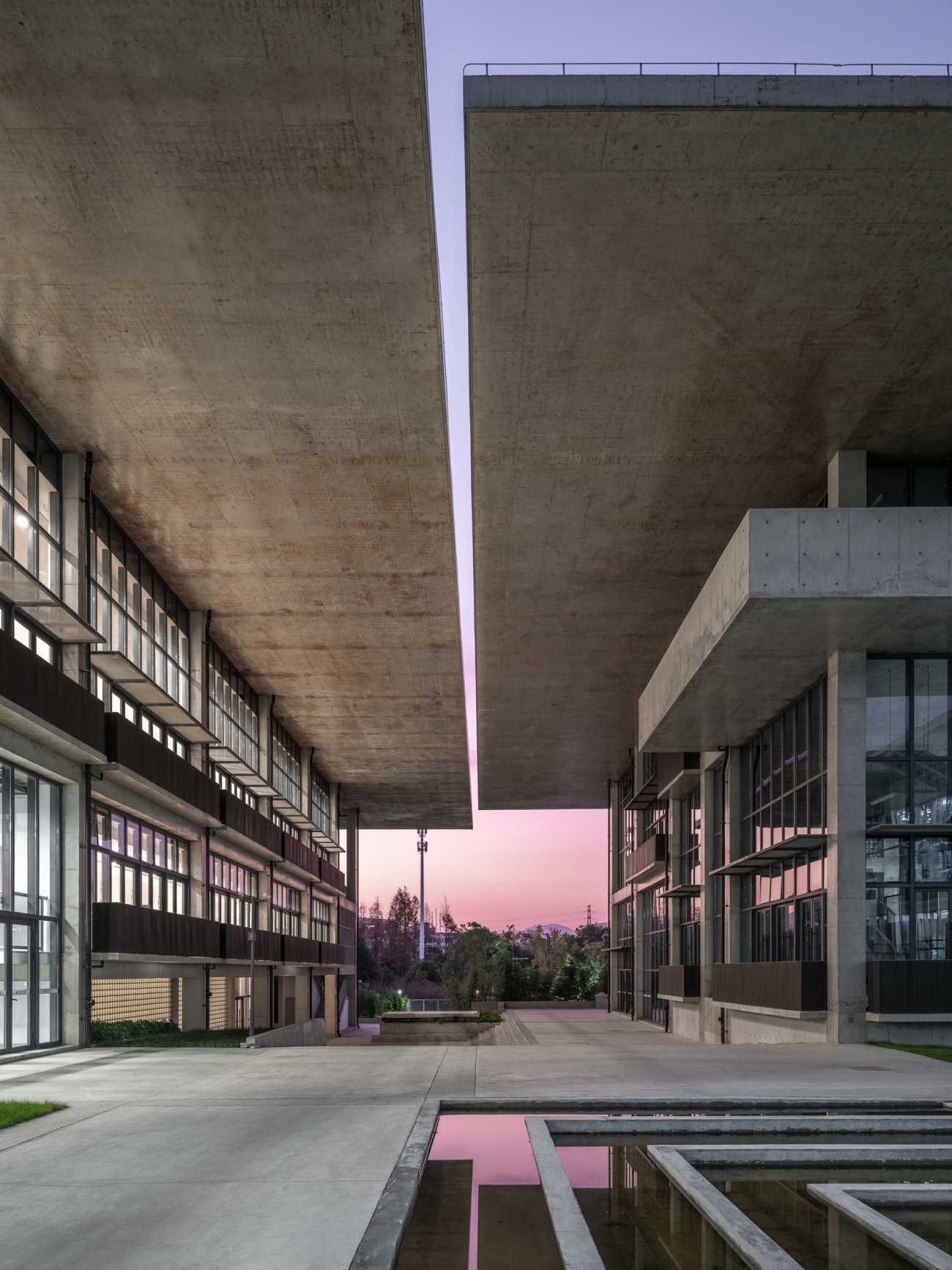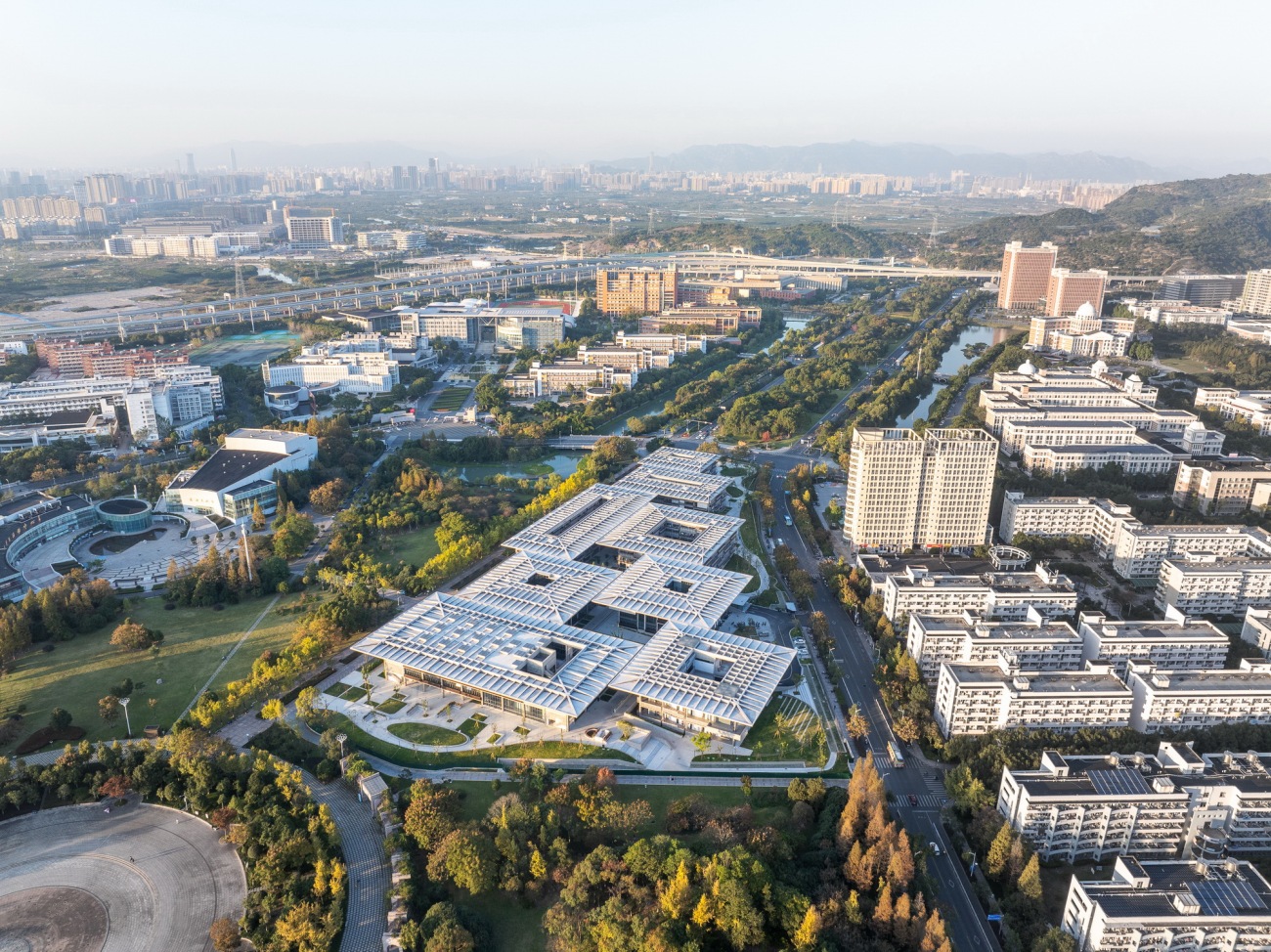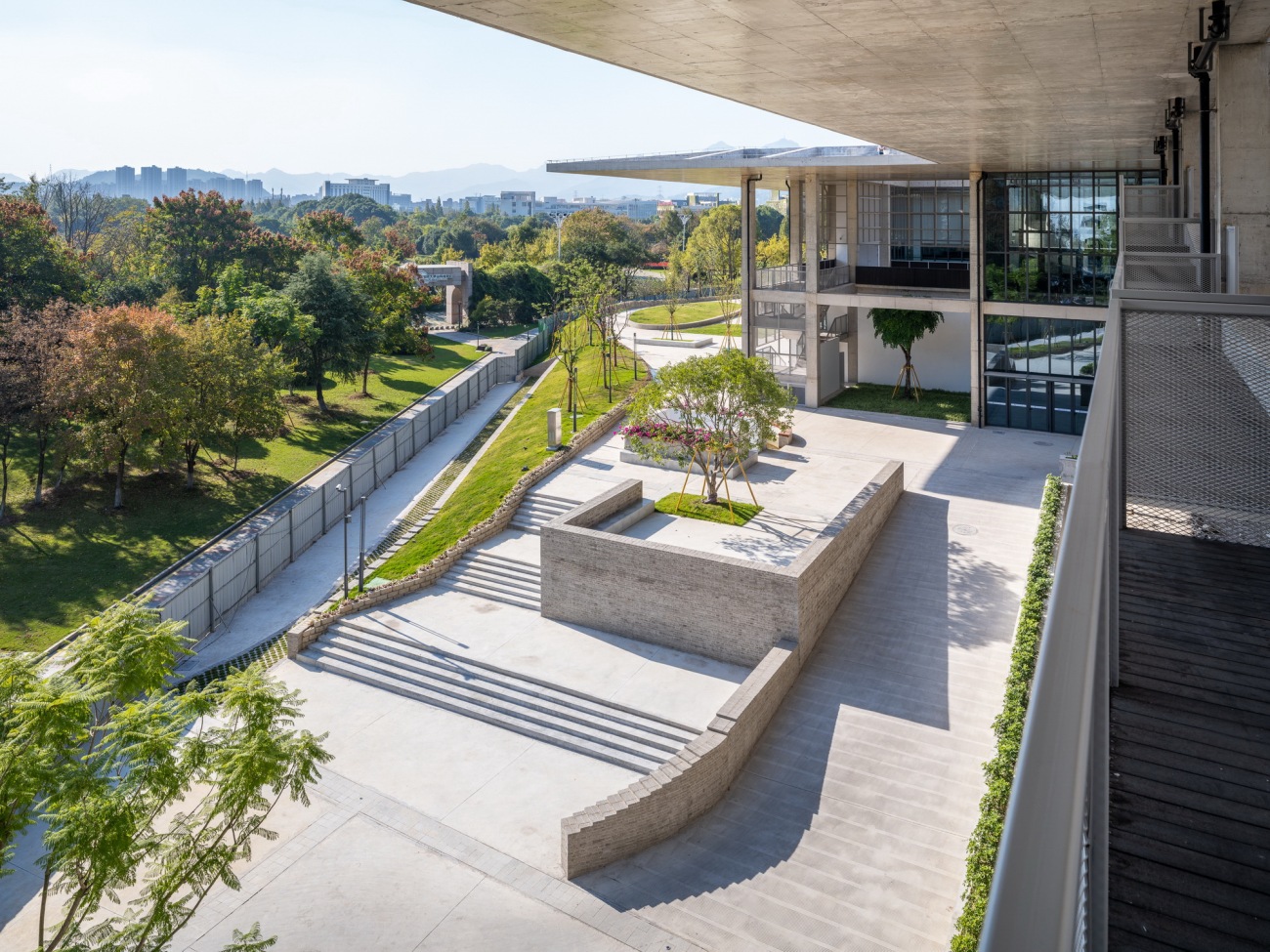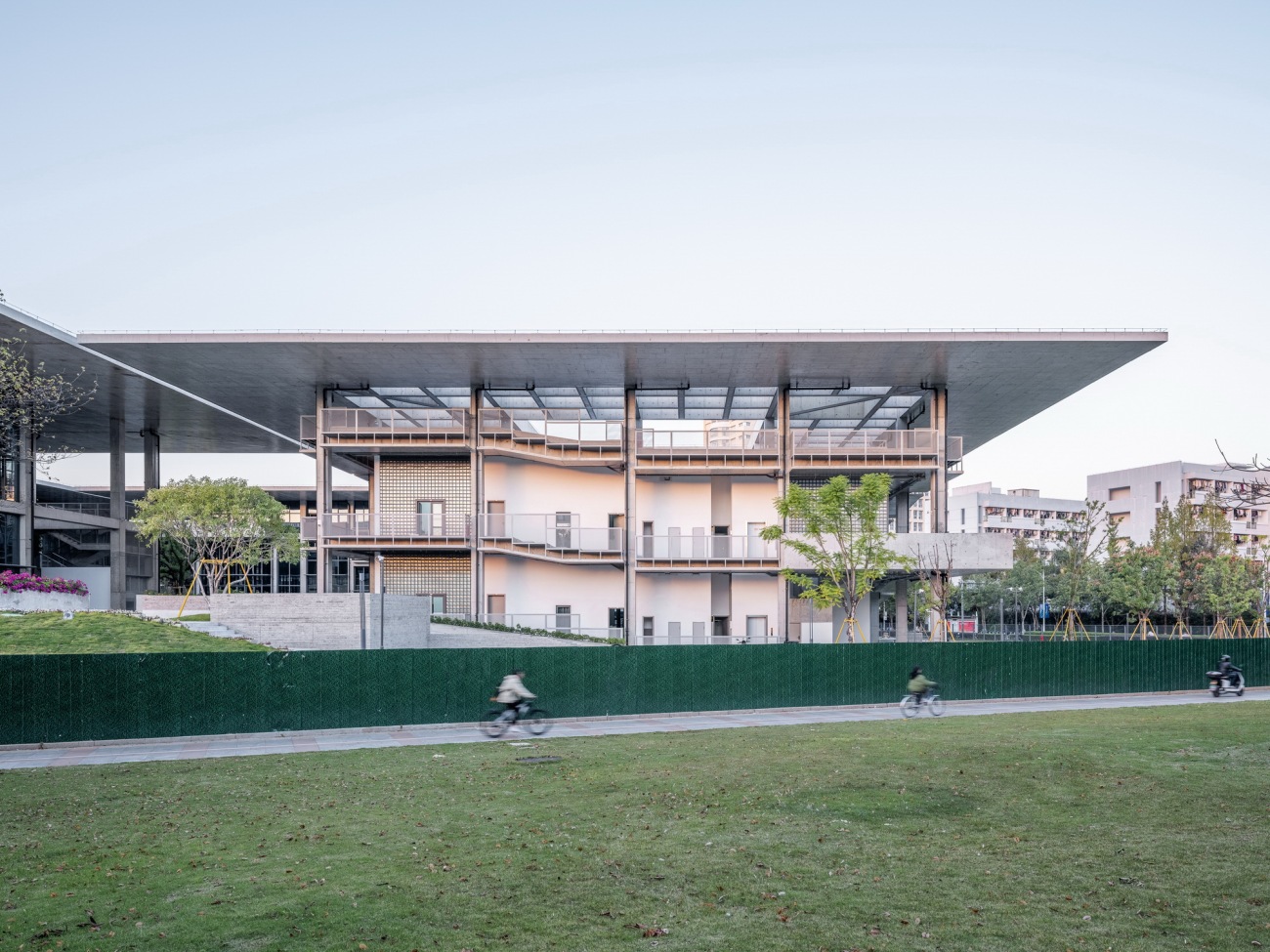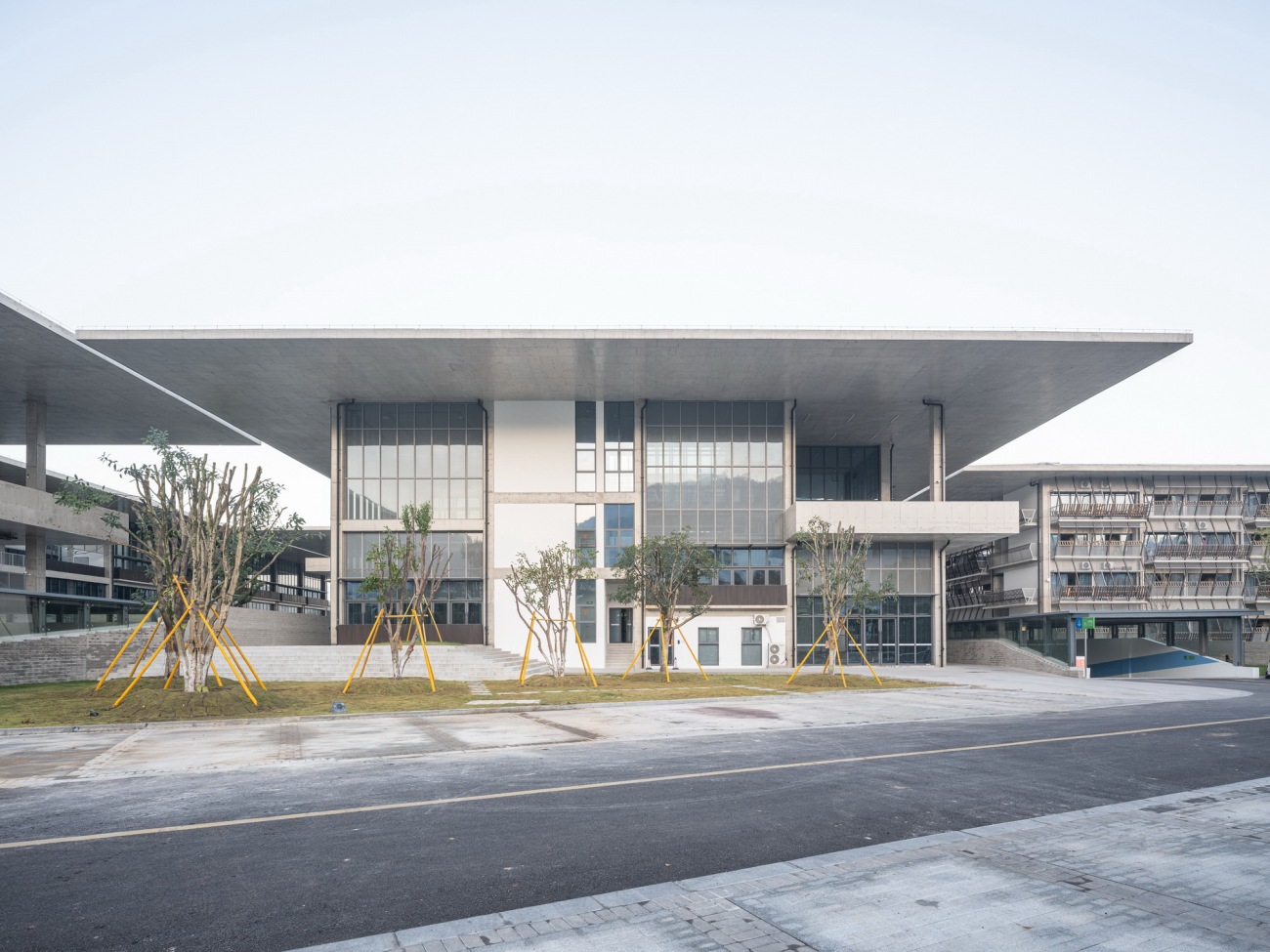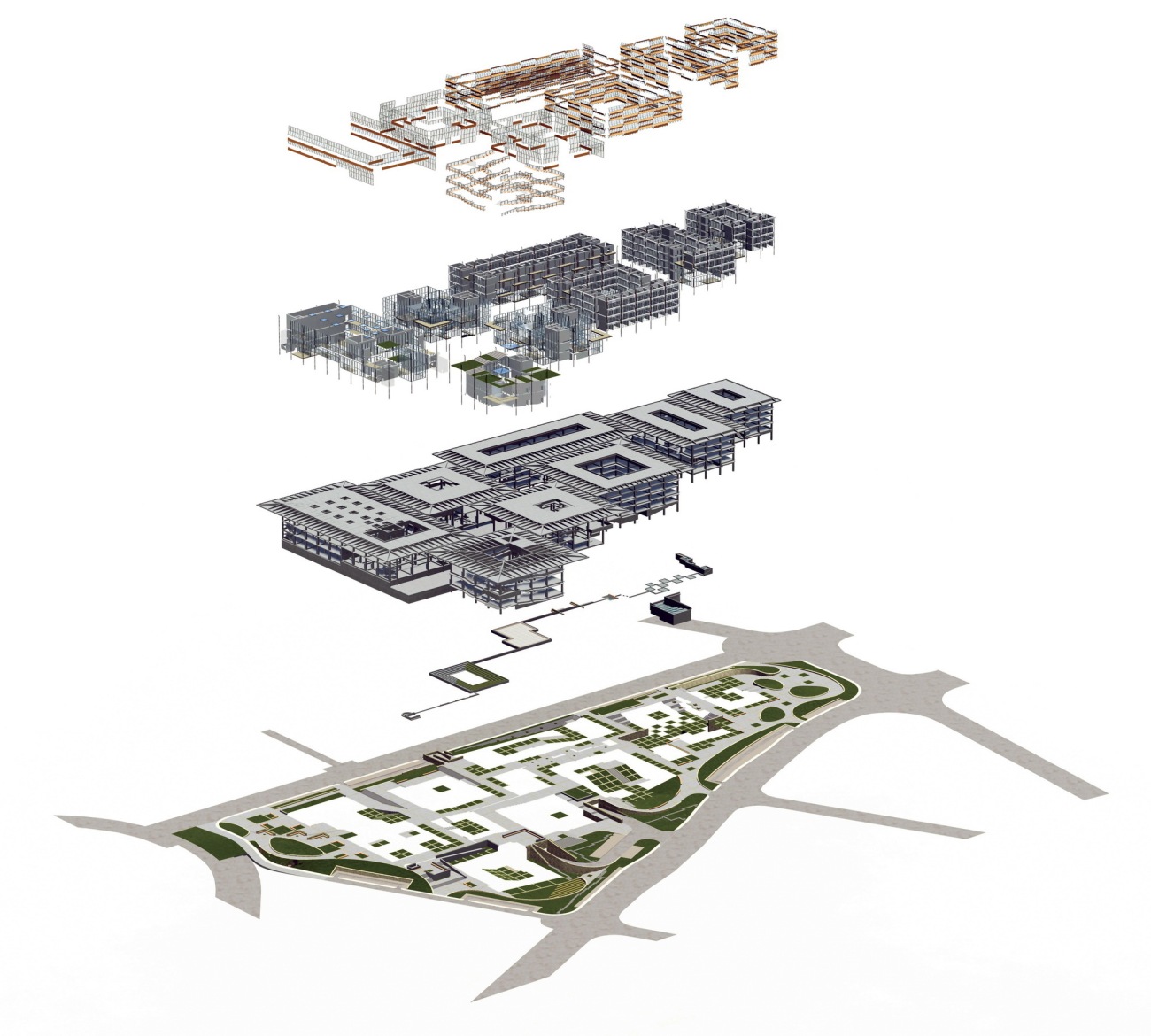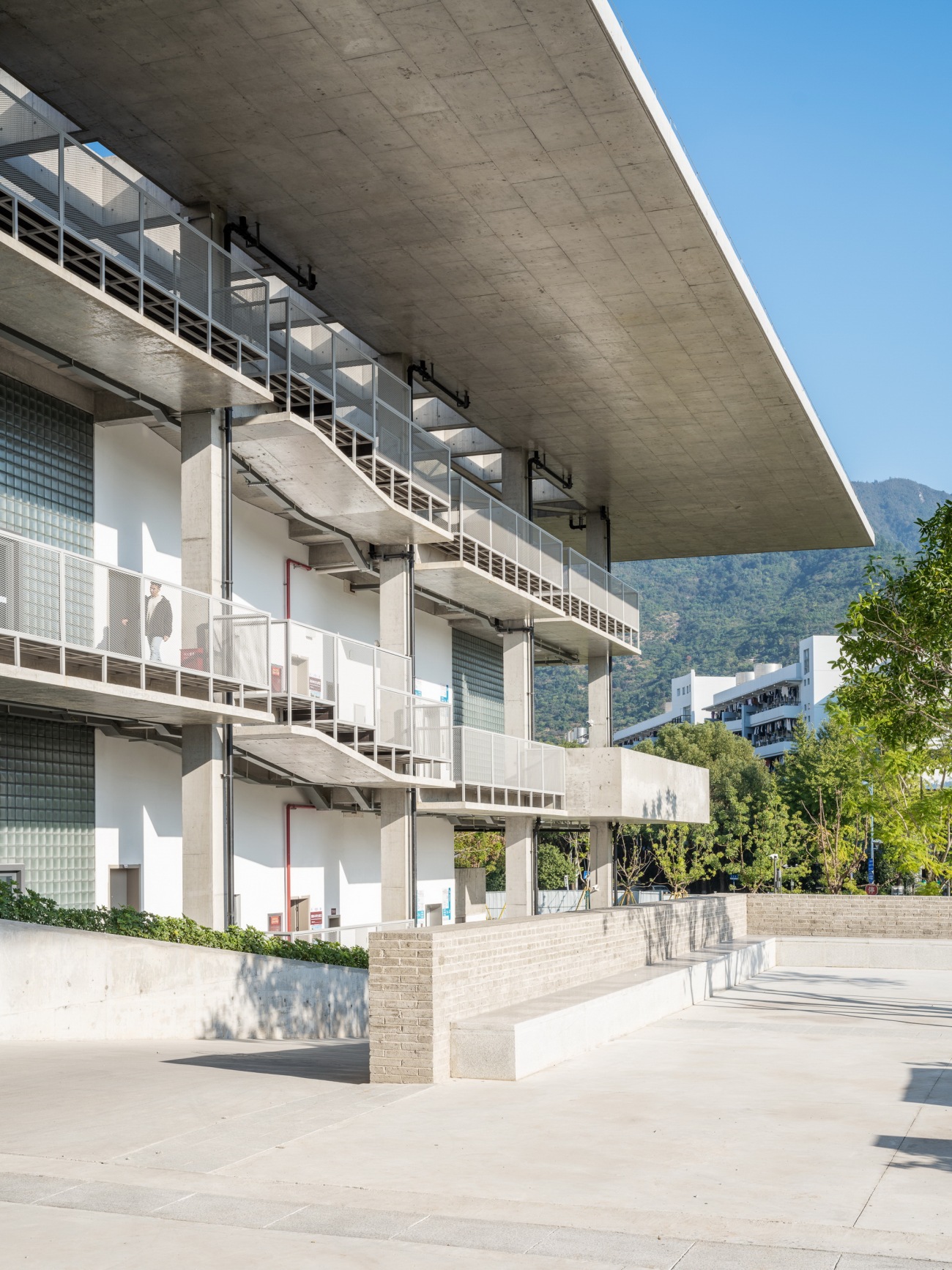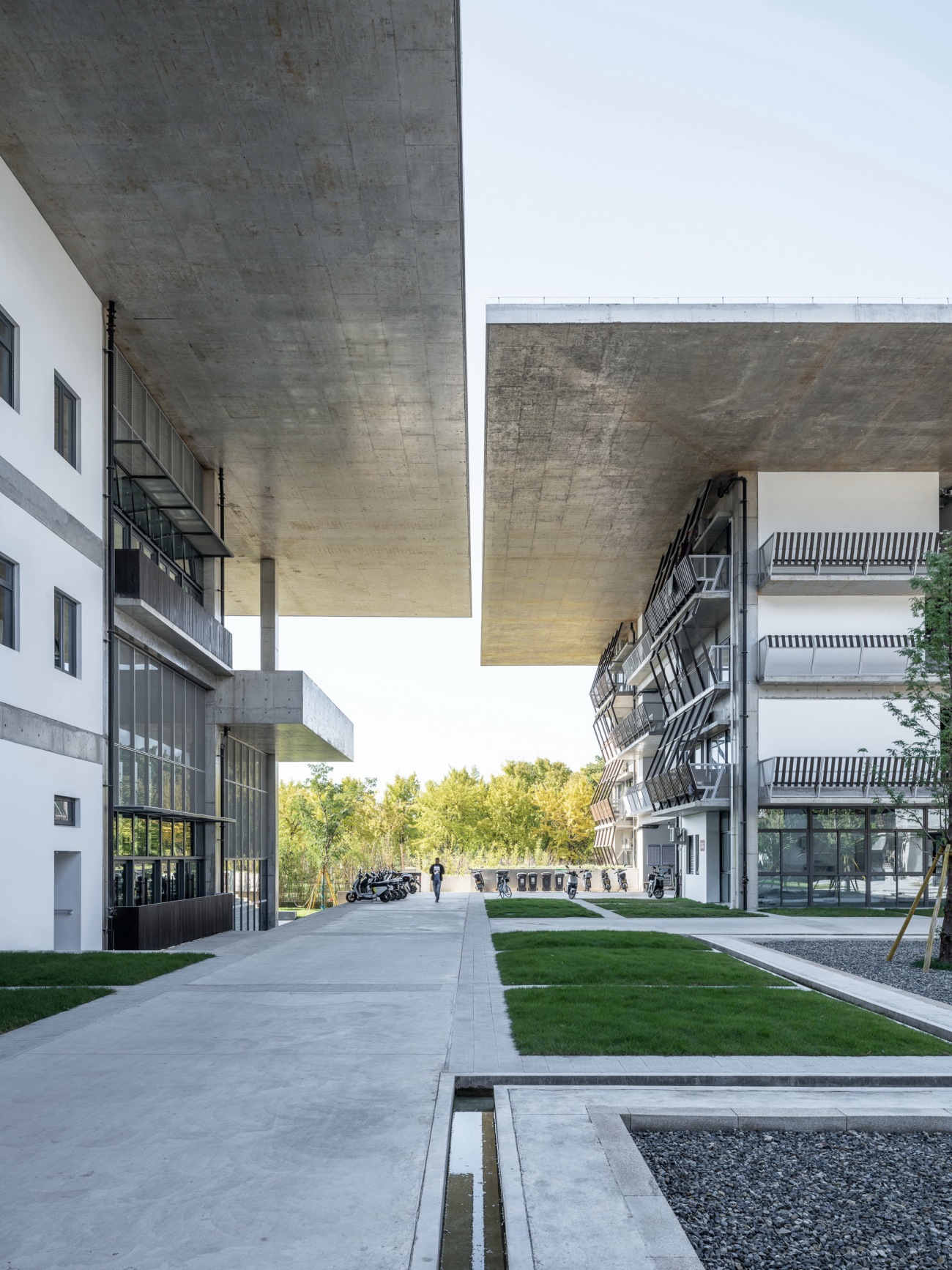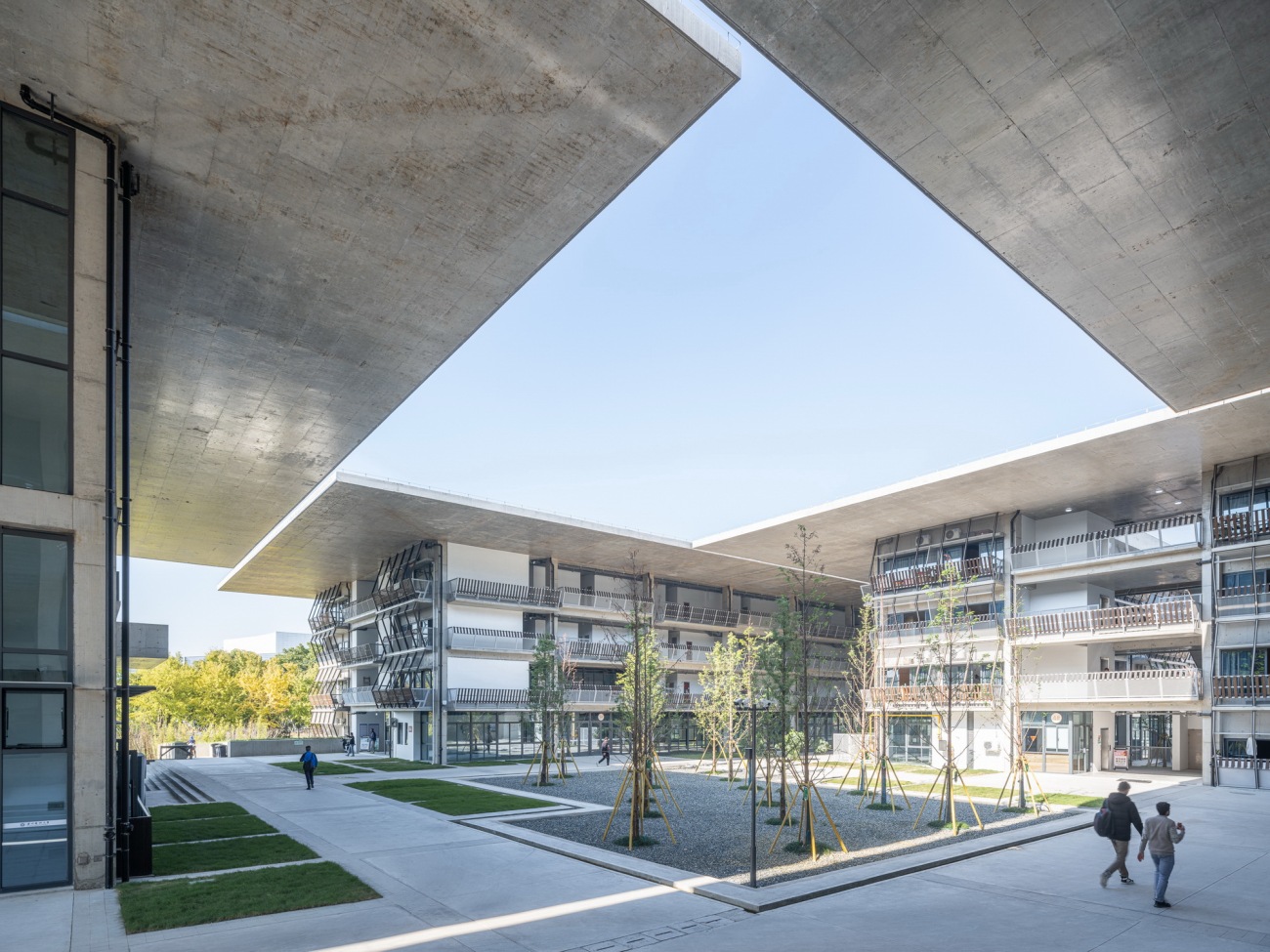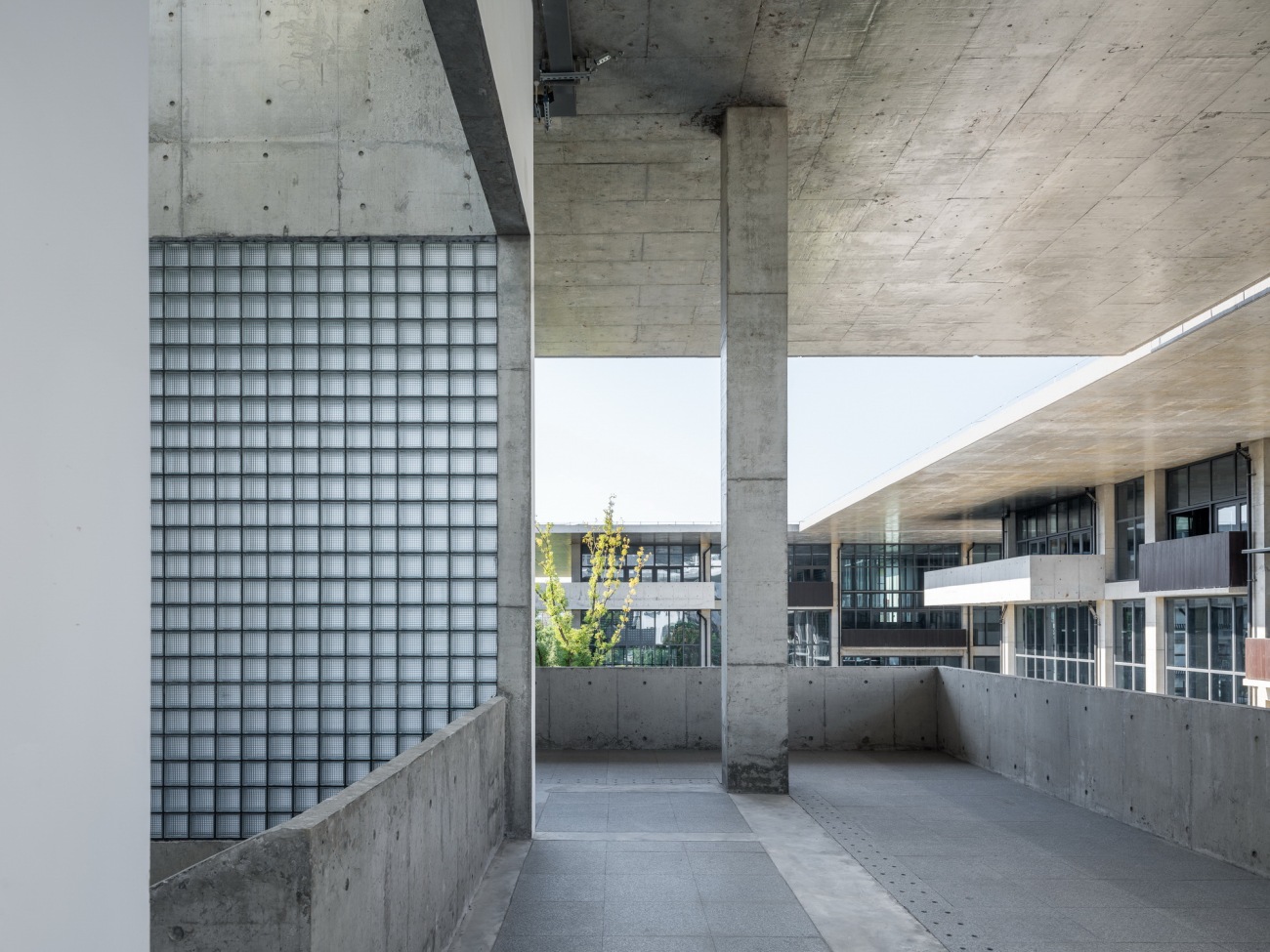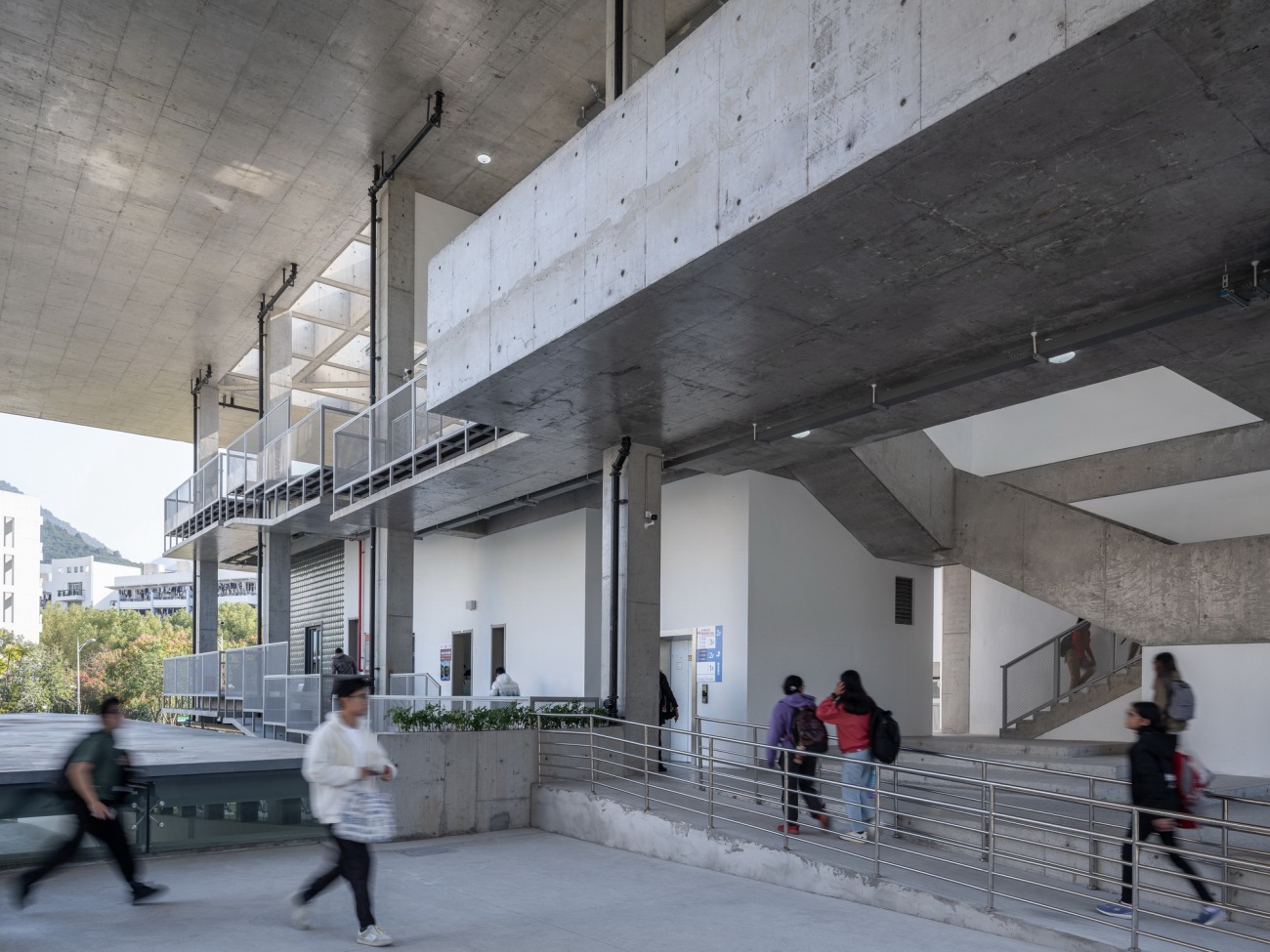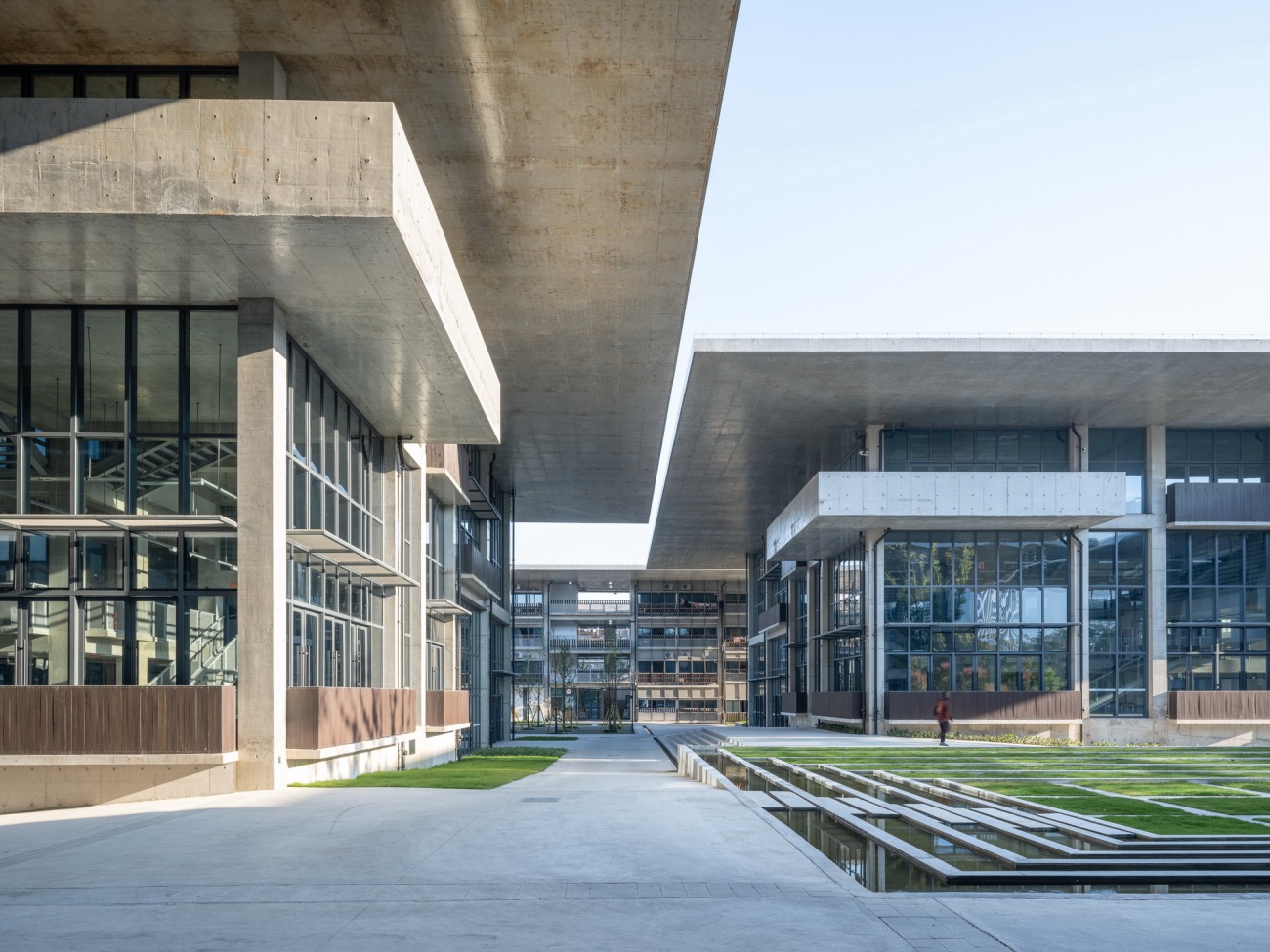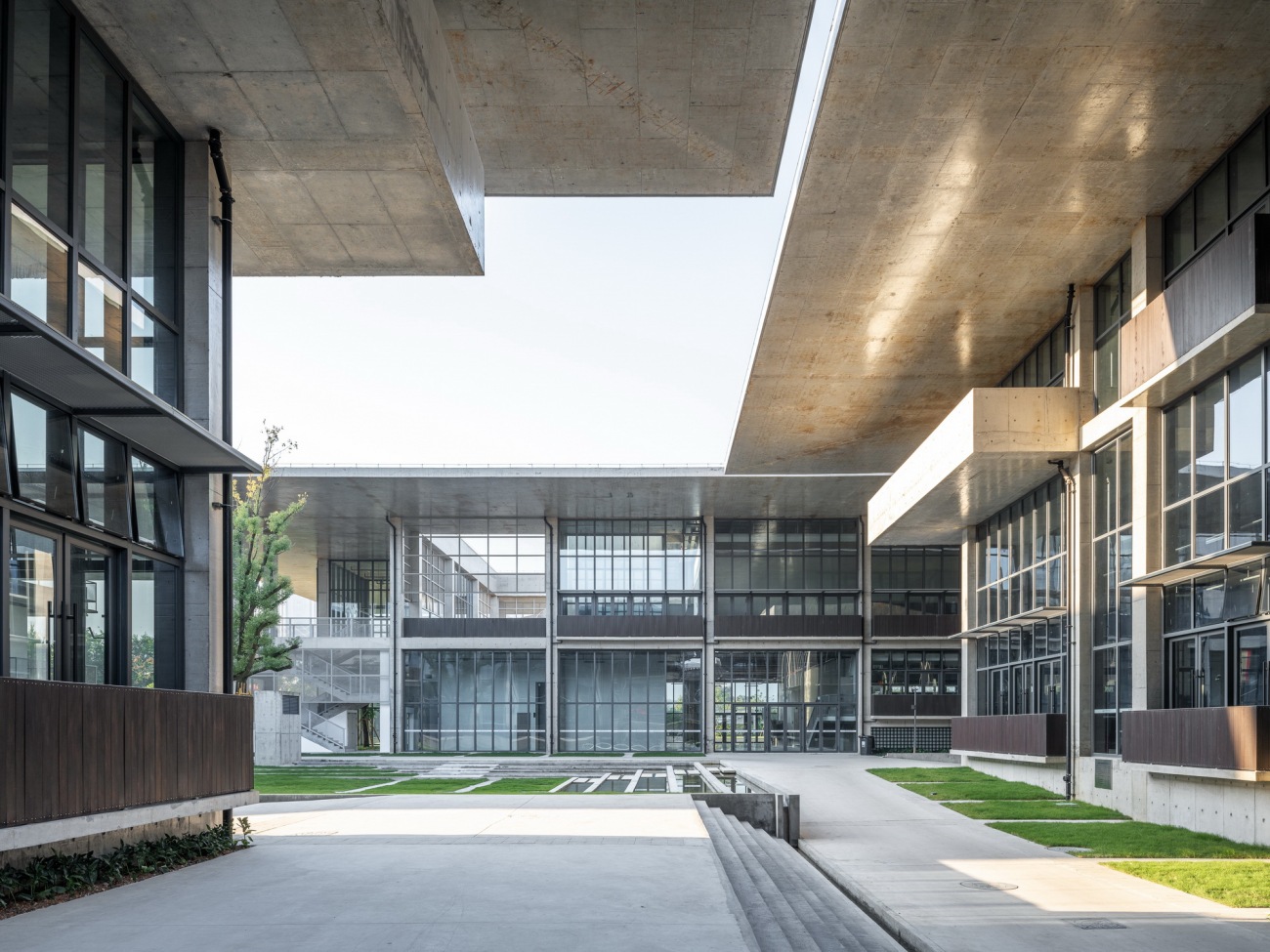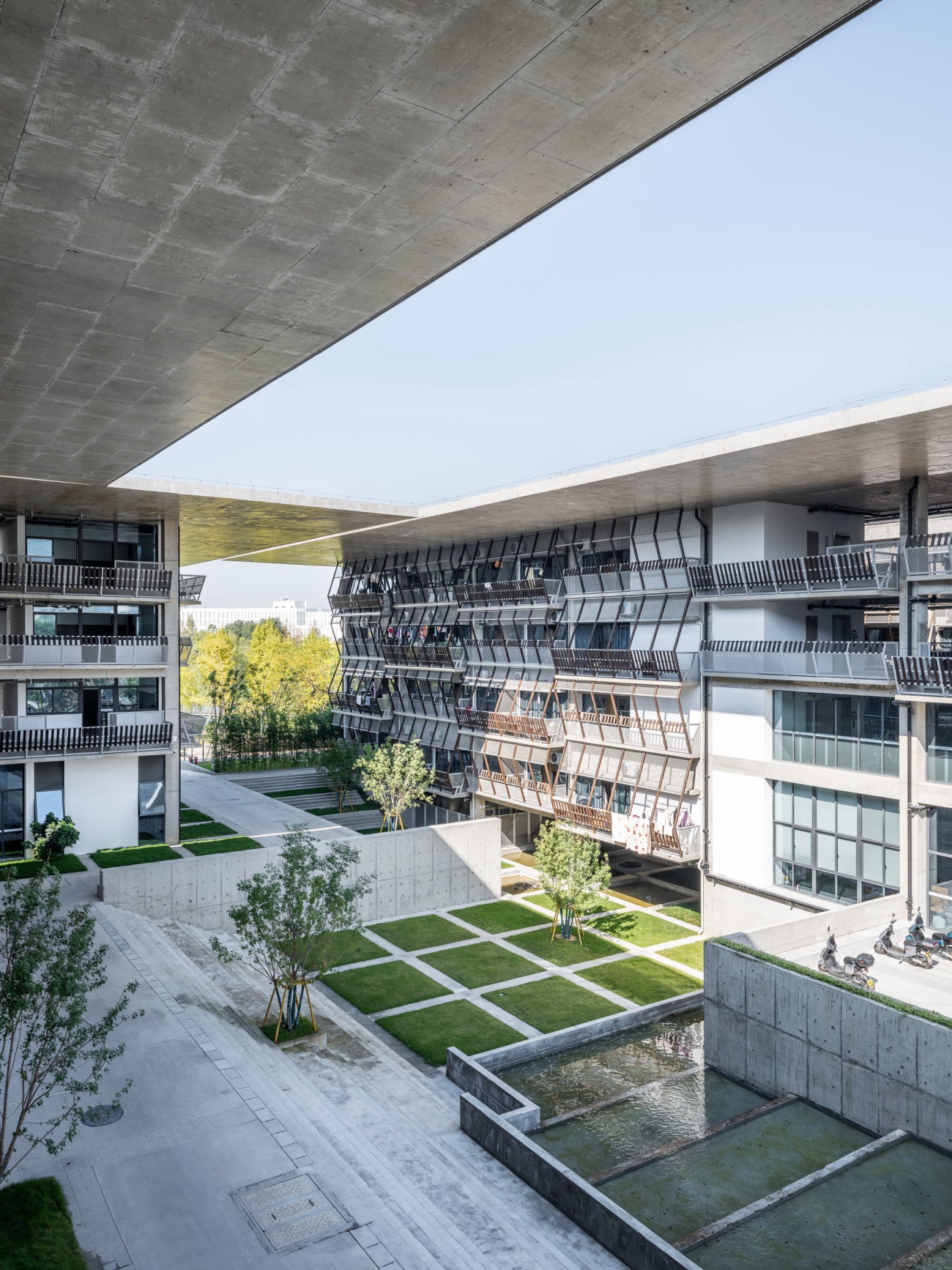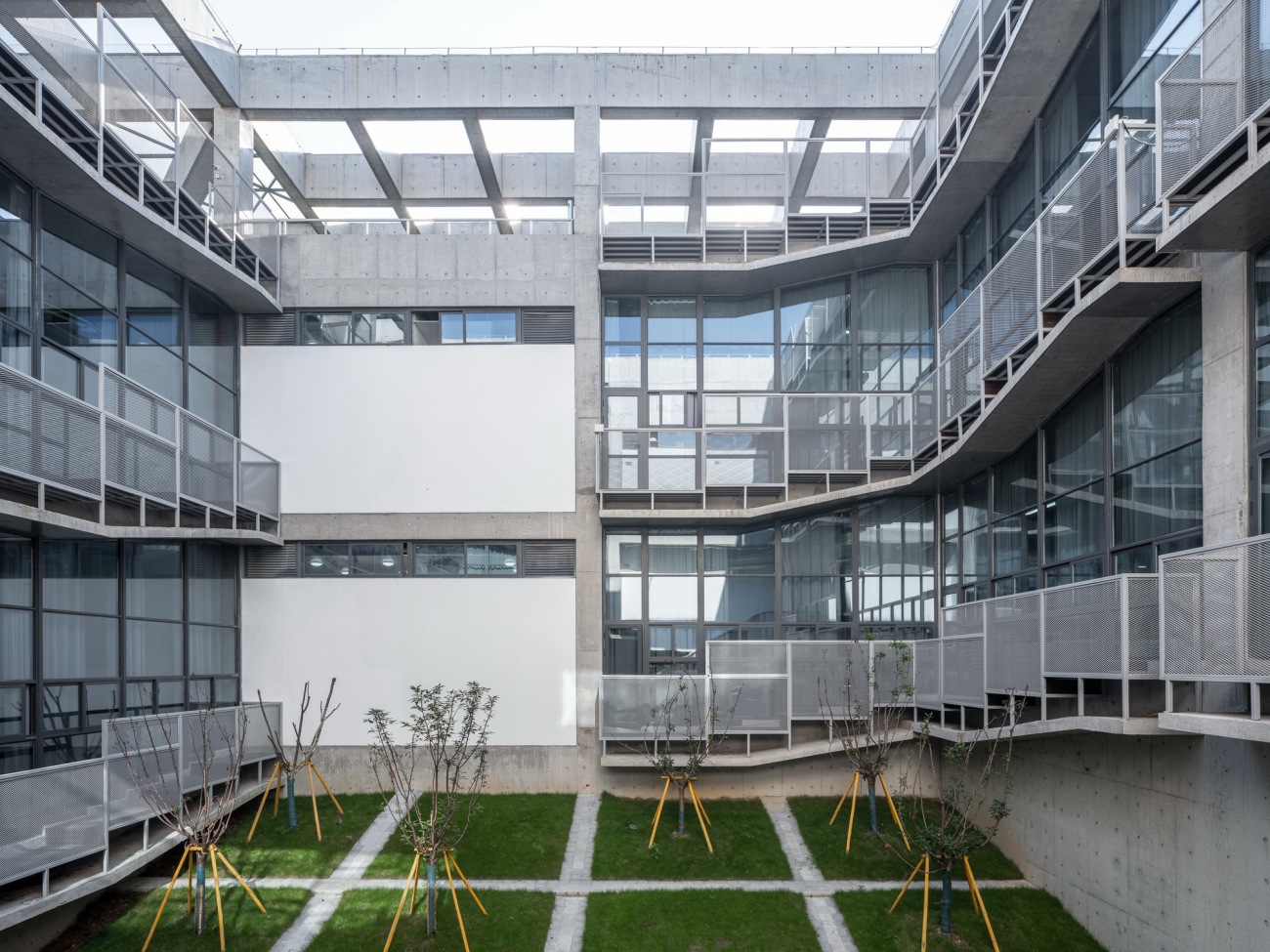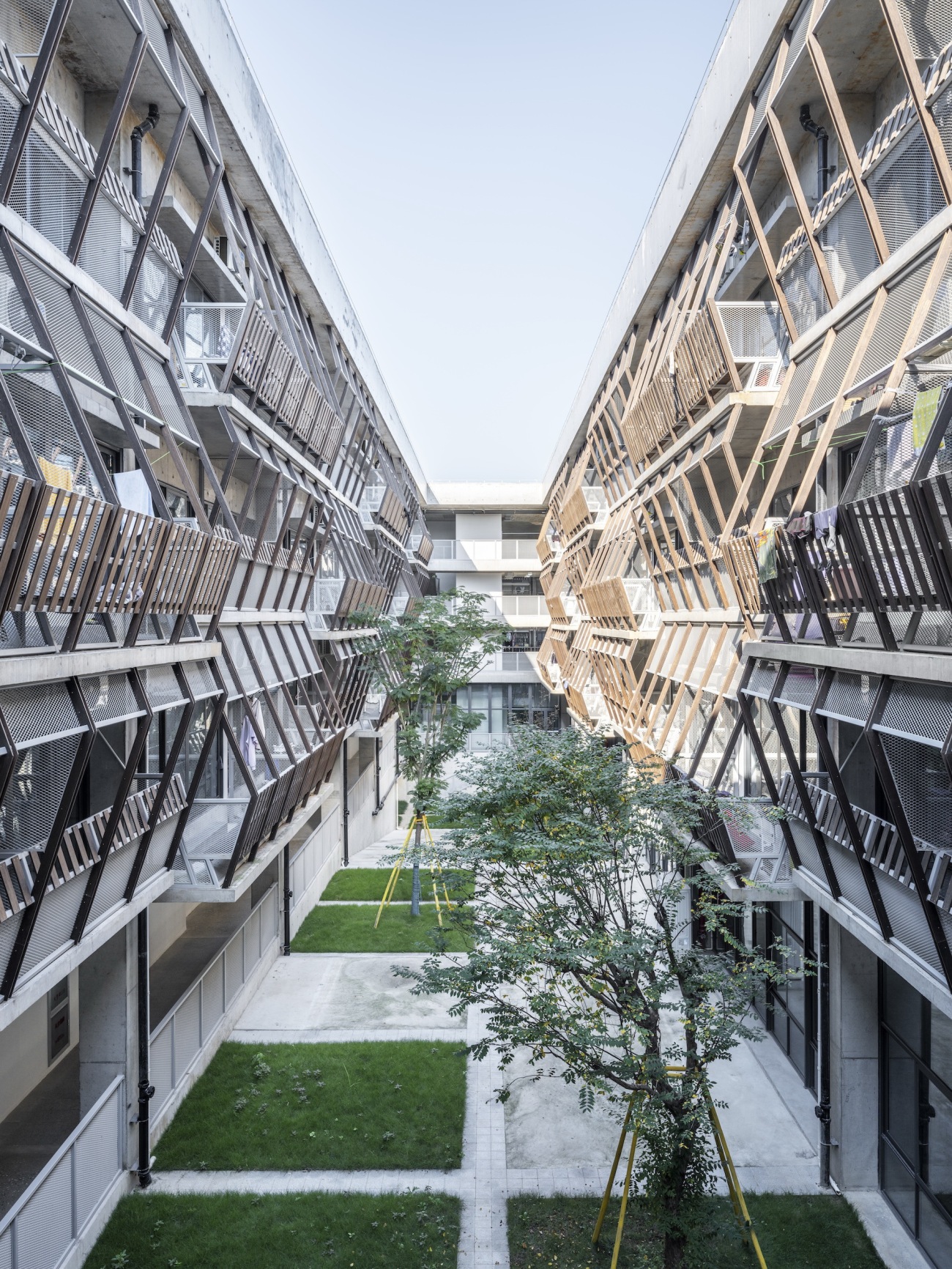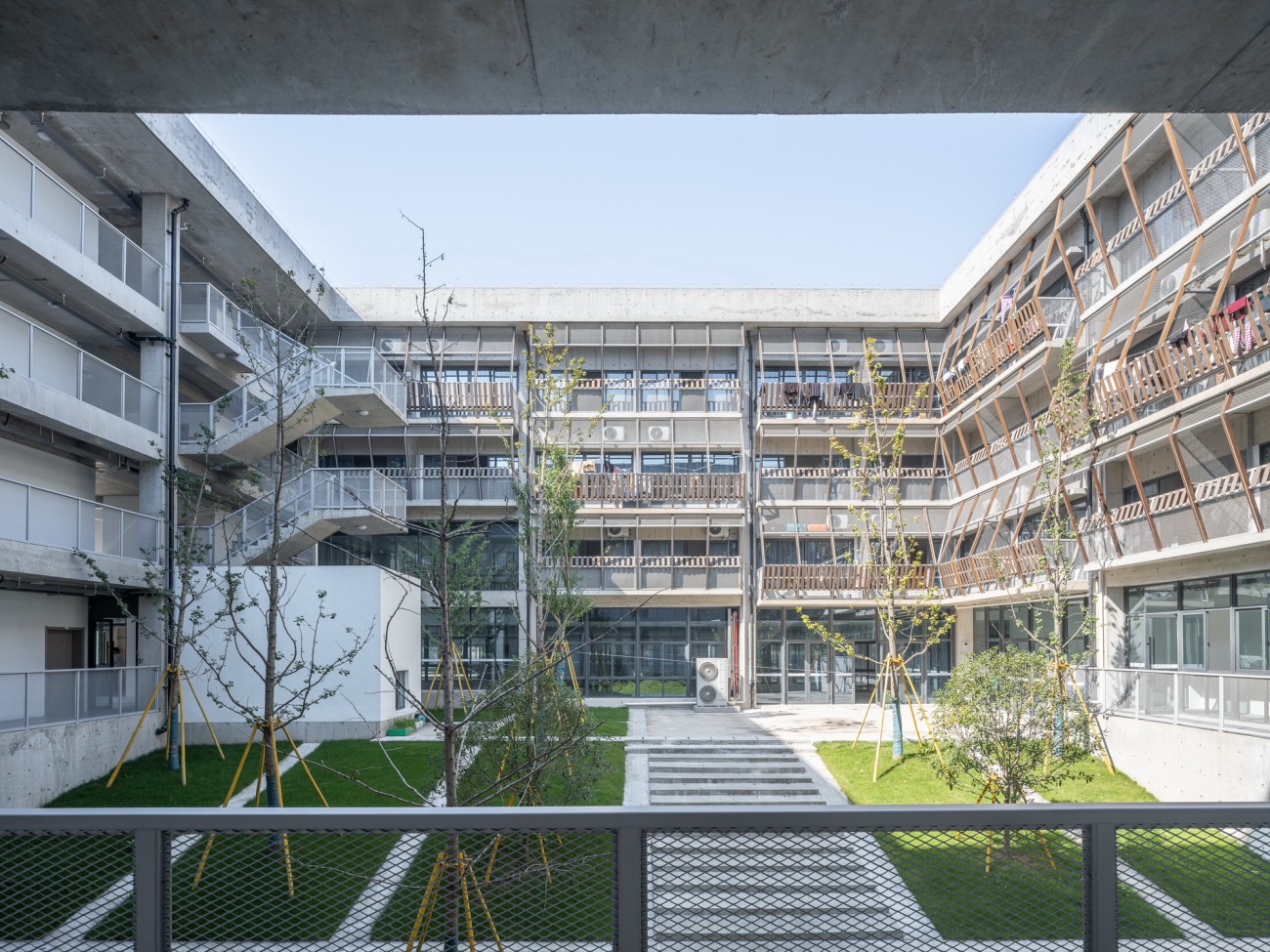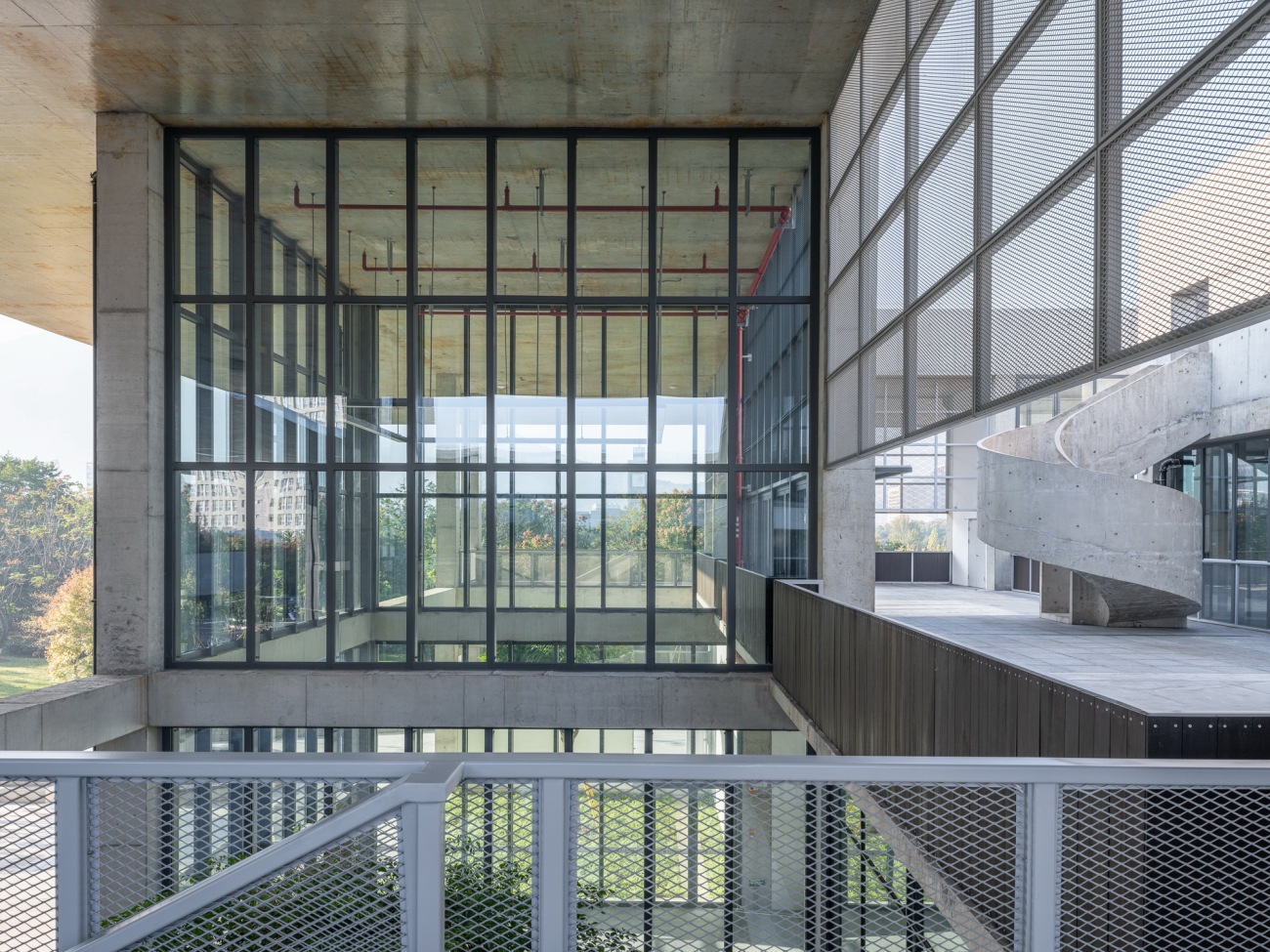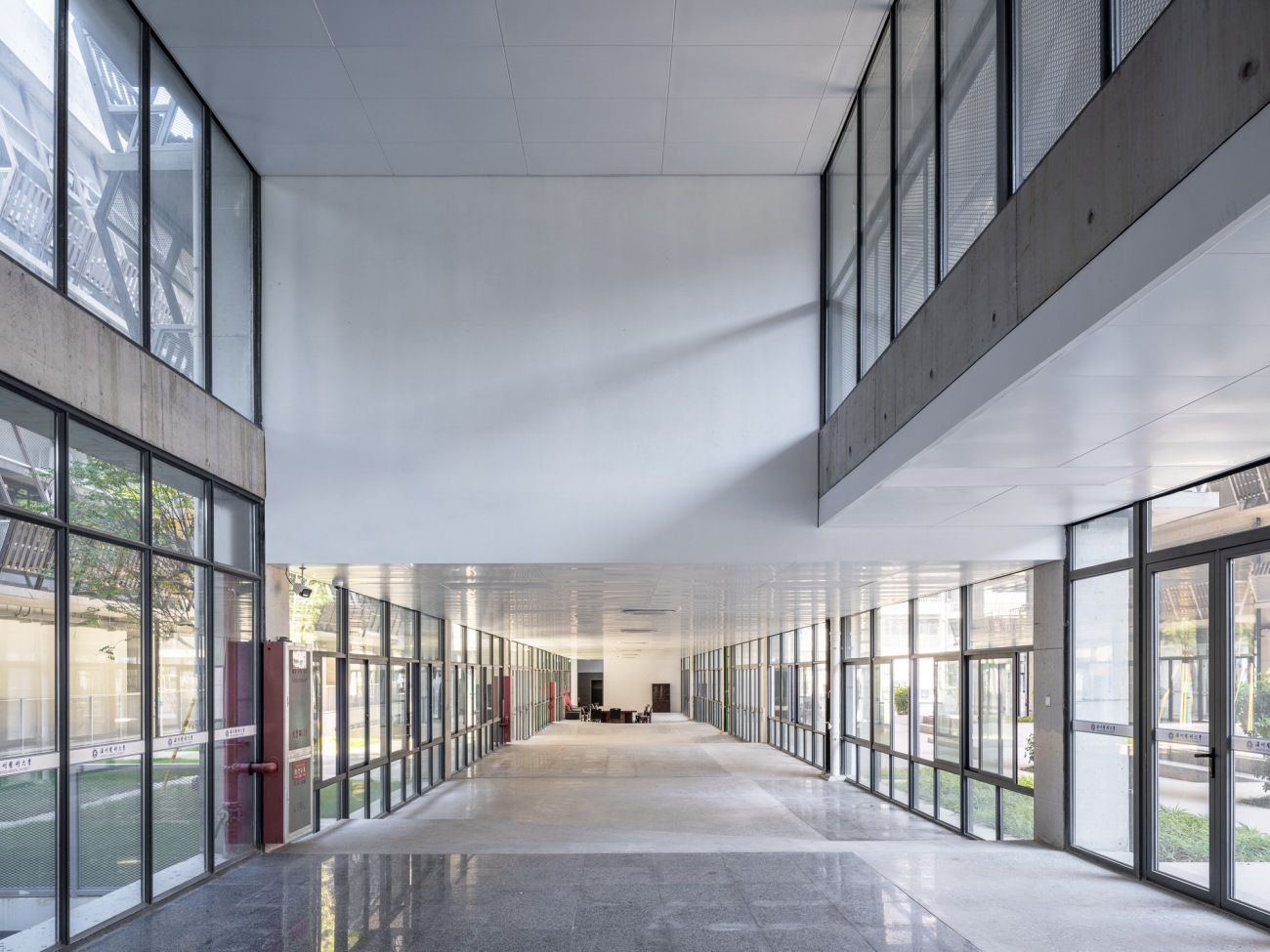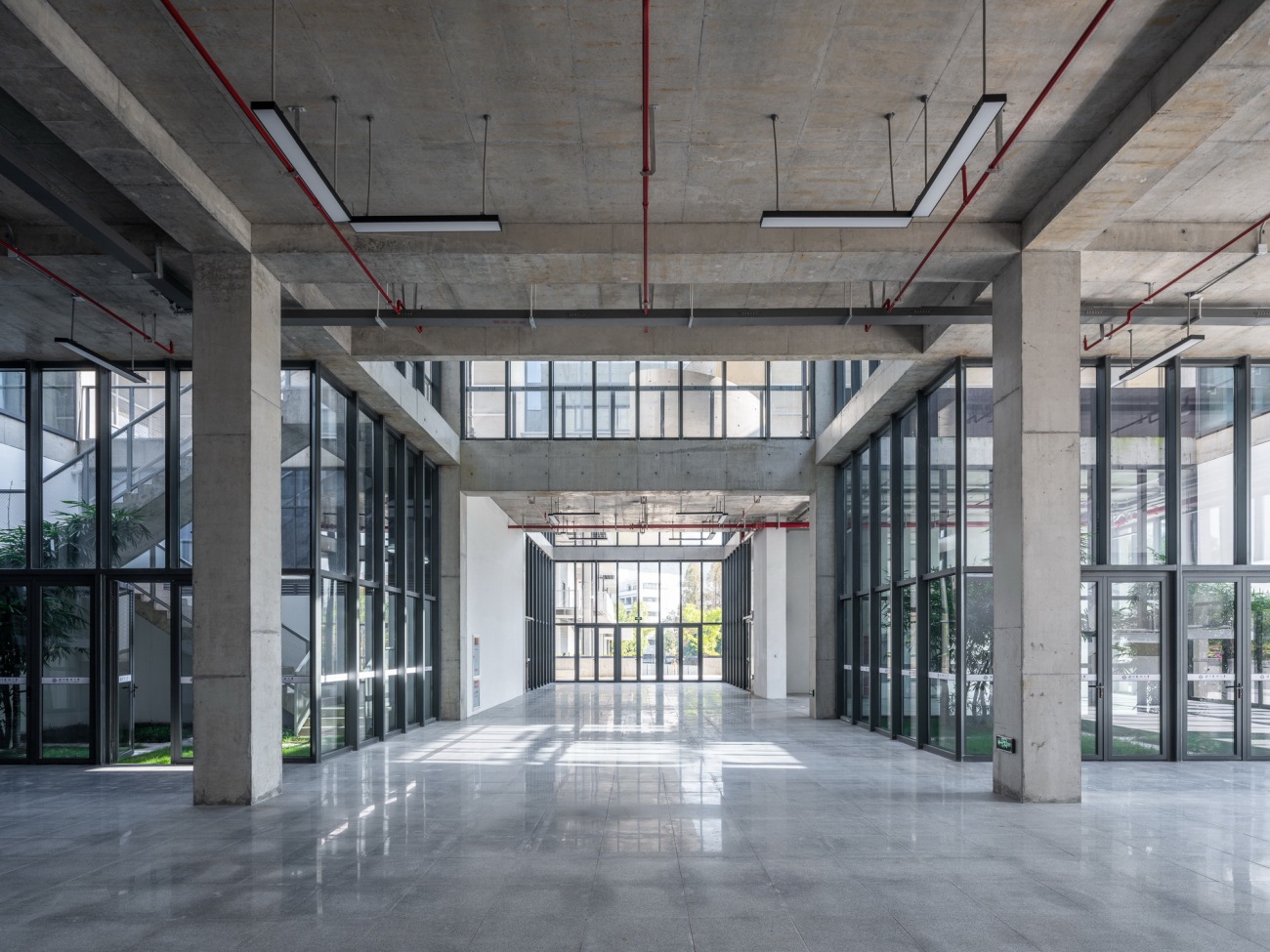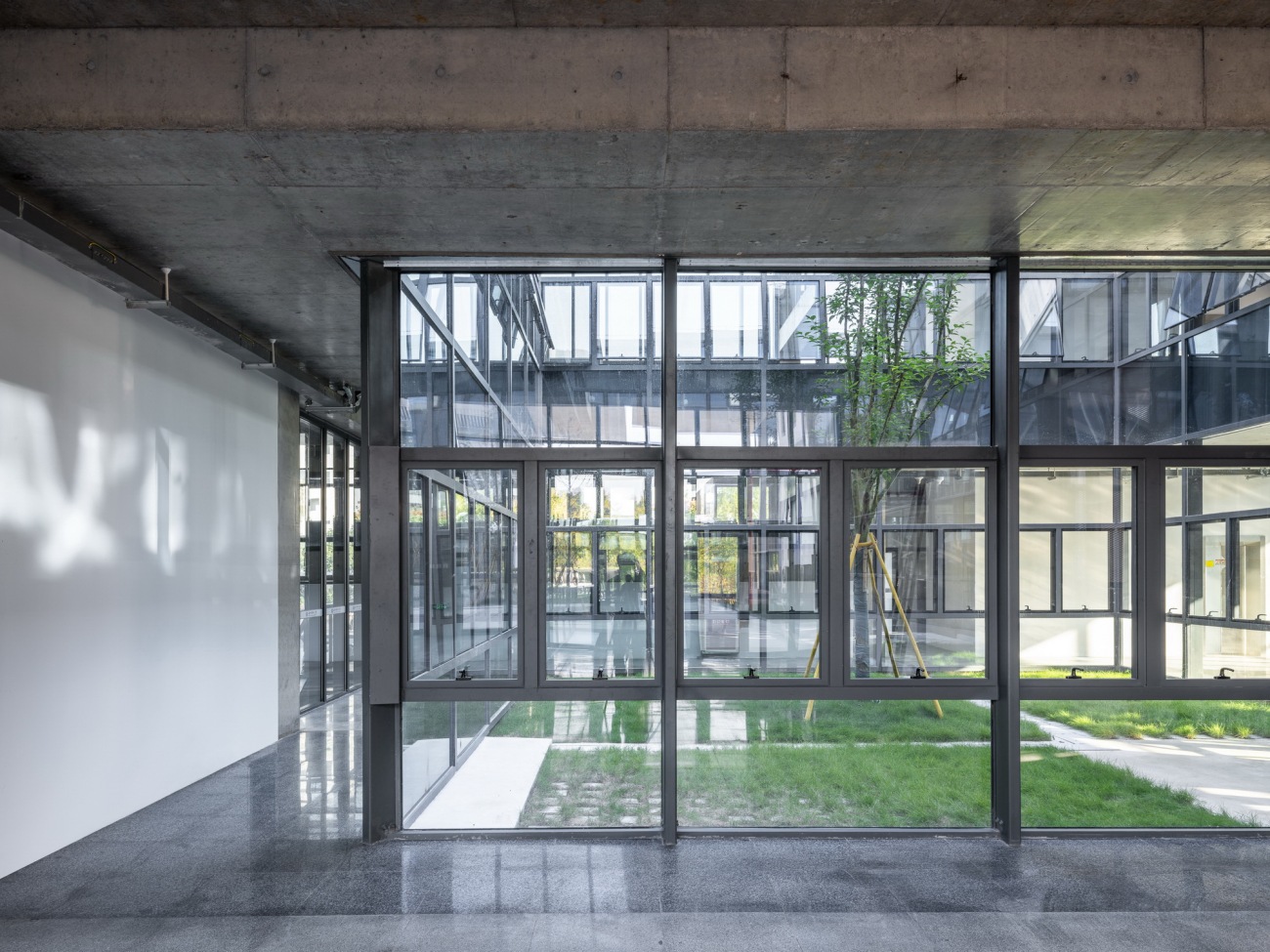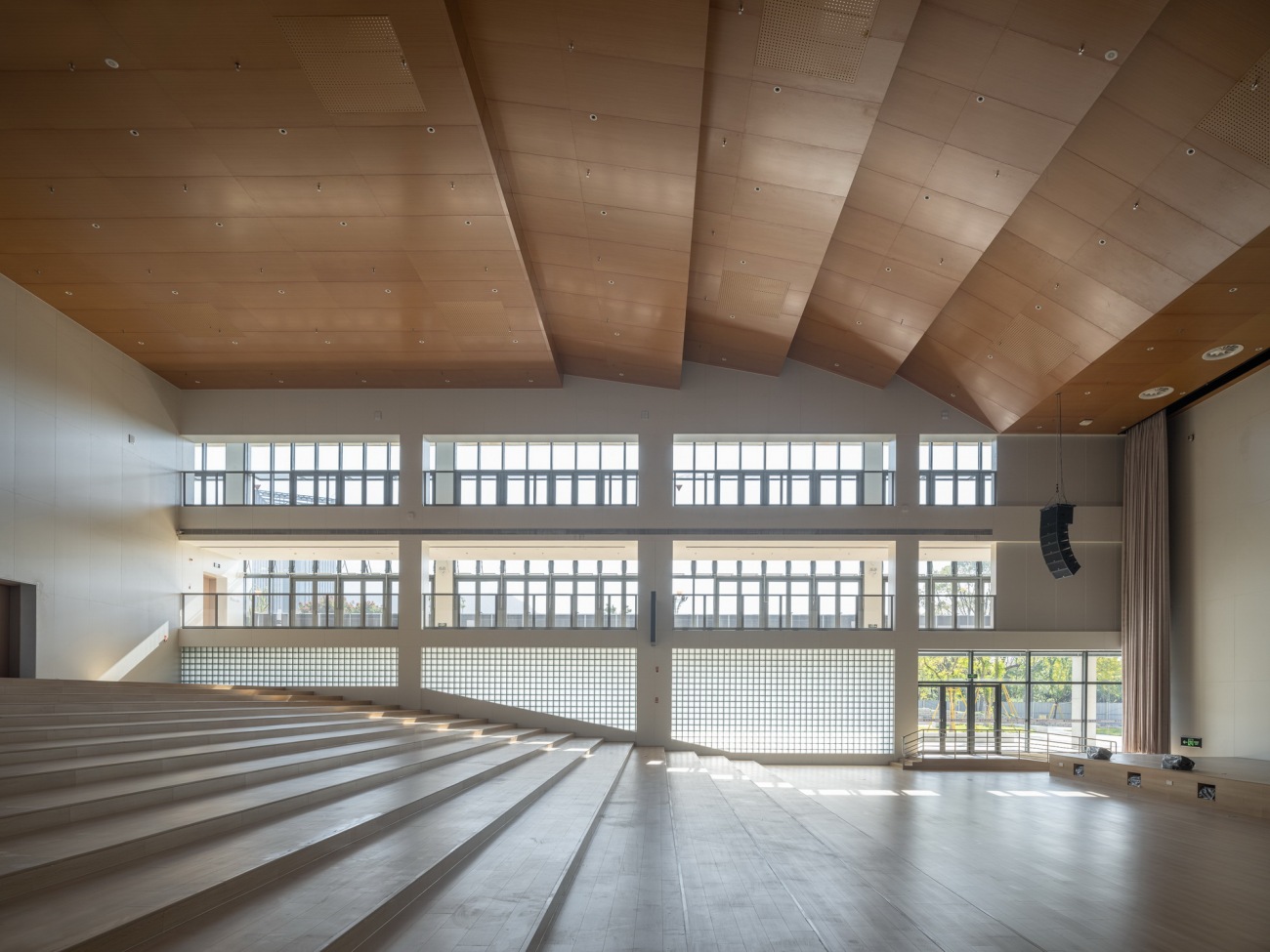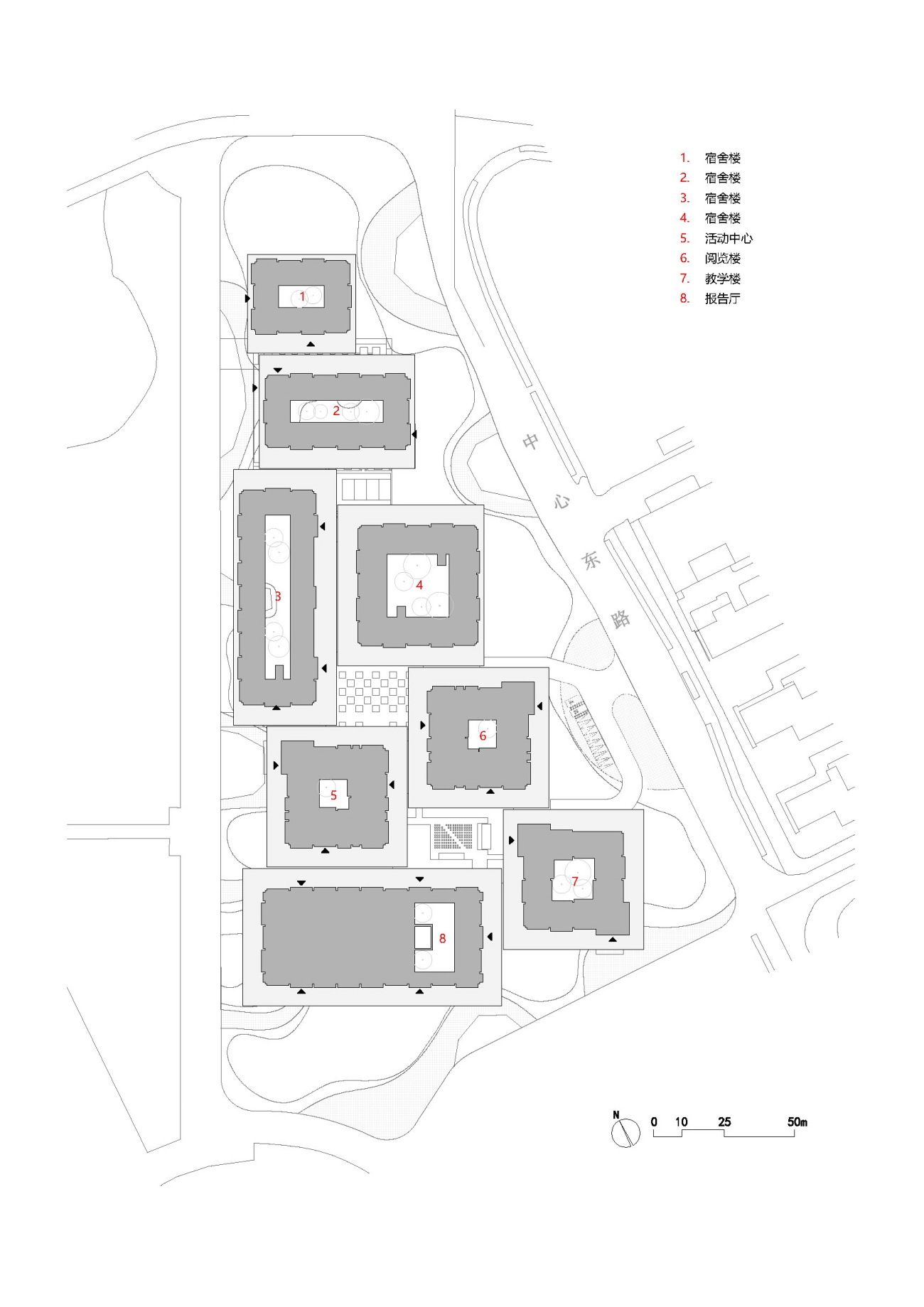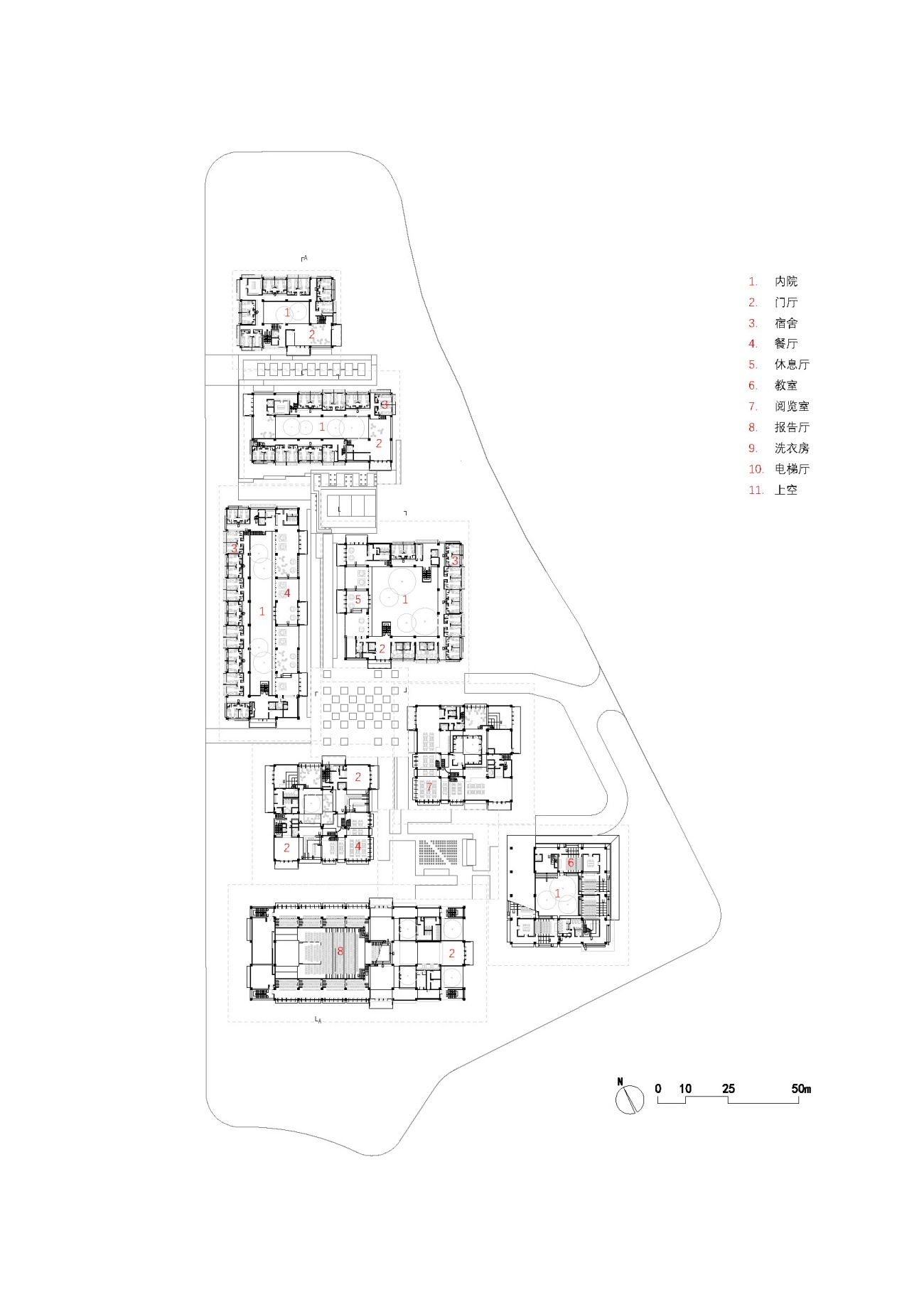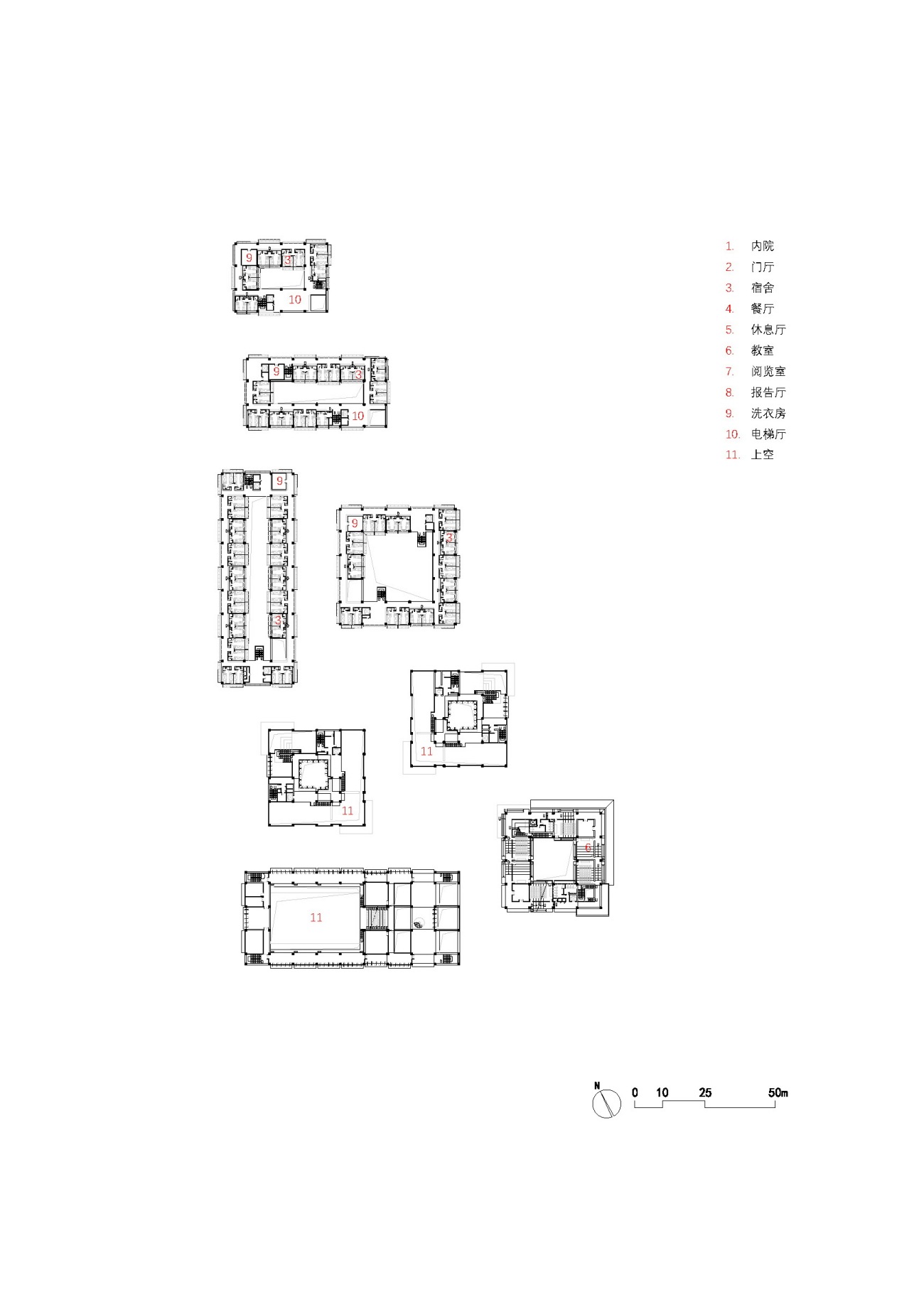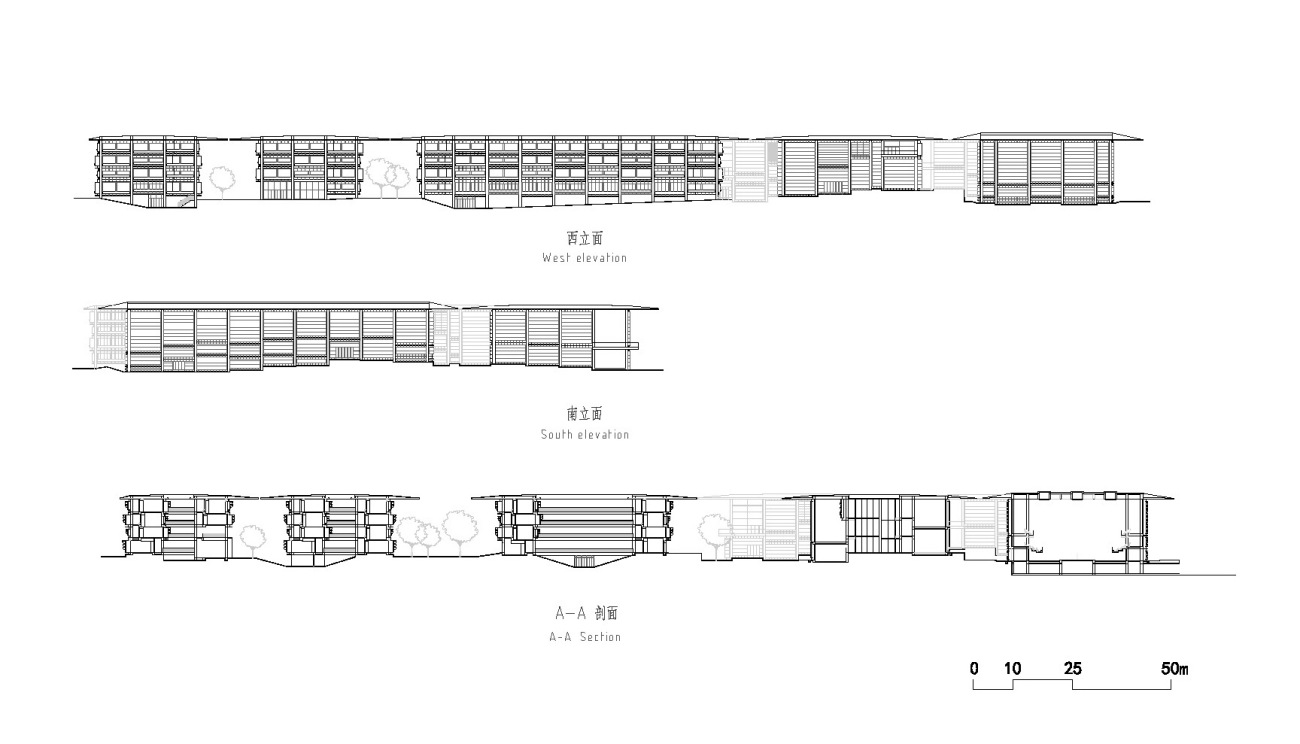01
气候主导设计
Climate-Driven Design
项目所在地温州,顾名思义,是一个气候温和的城市。我们由此想到,人和自然之间建立更亲密的关系,即较多地在户外活动和生活,在这里是否更具备实现的条件?气候的考虑成为了设计温州医科大学国际交流中心的起点。
Wenzhou, a city that has a name hinting at a mild climate. This prompted us to imagine a more intimate connection between people and nature, emphasizing more outdoor activities and living specifically. The climatic context became the genesis for conceptualizing the Wenzhou Medical University International Exchange Center.
▽南侧鸟瞰
Bird's eye view from the south side
▽鸟瞰8栋伞形建筑组成的整体
Bird's eye view of a complex of 8 buildings of umbrella form
该项目用地的周围被绵延的树冠环绕,环境优美。为了达到建筑与自然融合的目标,首先,我们采取化整为零的策略,将内容丰富的交流中心拆解成由8栋4层高的建筑组成的群体。8栋建筑承担的功能分别为宿舍楼(4栋)、活动中心、阅览楼、教学楼及报告厅。
The specific site, embraced by continuous tree canopies, makes a pleasing landscape. To push the notion of harmonizing architecture with nature, our foremost approach involved disassembling the content-rich exchange center into a unity of eight 4-story buildings. Each of these structures is dedicated to a specific purpose: Dormitories (4 blocks), Activity Center, Library, Teaching Building and Lecture Hall.
▽从教学楼阳台看公园
View of the park from a balcony of Teaching Building
▽教学楼南立面
South facade of Teaching Building
▽阅览楼
Library
02
四层空间
Four Layers of Spaces
进而,我们打破建筑的封闭性,为单体建筑设计了从中心向边缘的四层空间:中心庭院(室外)、空调区(室内)、廊下(半室内)、檐下(半室外),后二者可视为绝对室内与绝对室外之间的过渡,即灰空间。
Subsequently, the typically closed-up building is broken, turning into a four-layered spatial arrangement from the center to the periphery: the central courtyard (outdoor),the air-conditioned zone (indoor),the veranda (semi-indoor), and the area under the overhang(semi-outdoor). The latter two layers serve as transitions betweenindoor and outdoor spaces, constituting a Gray Space.
▽空间层次示意图
Diagram of spatial layering
由悬挑屋顶覆盖、进深10米的檐下空间继承了中国建筑木构深檐的传统,赋予了建筑单体一个伞形的剖面。我们将8个单体的檐下都置在一个平面上,将该建筑群的屋顶连成一片概念或抽象的连续树冠,仅被3个大院落,其中2个为四合1个为三合,和8个小院落及单体之间50厘米宽的缝隙穿破。
Shaded by projecting roofs and inheriting the traditional deep eaves from Chinese timber architecture, each building adopts an umbrella-inspired section with a 10m deep cantilever. The roofs of the entire complex are thus joined into an abstract continuous "tree canopy" by aligning the eaves of the eight structures on the same plane. This canopy is only disrupted by three large courtyards - two enclosed on four sides and one on three – and with 50cm wide gaps between the 8 small-courtyard-punctured individual buildings.
▽张永和手绘概念草图
Conceptual sketches by Yung Ho Chang
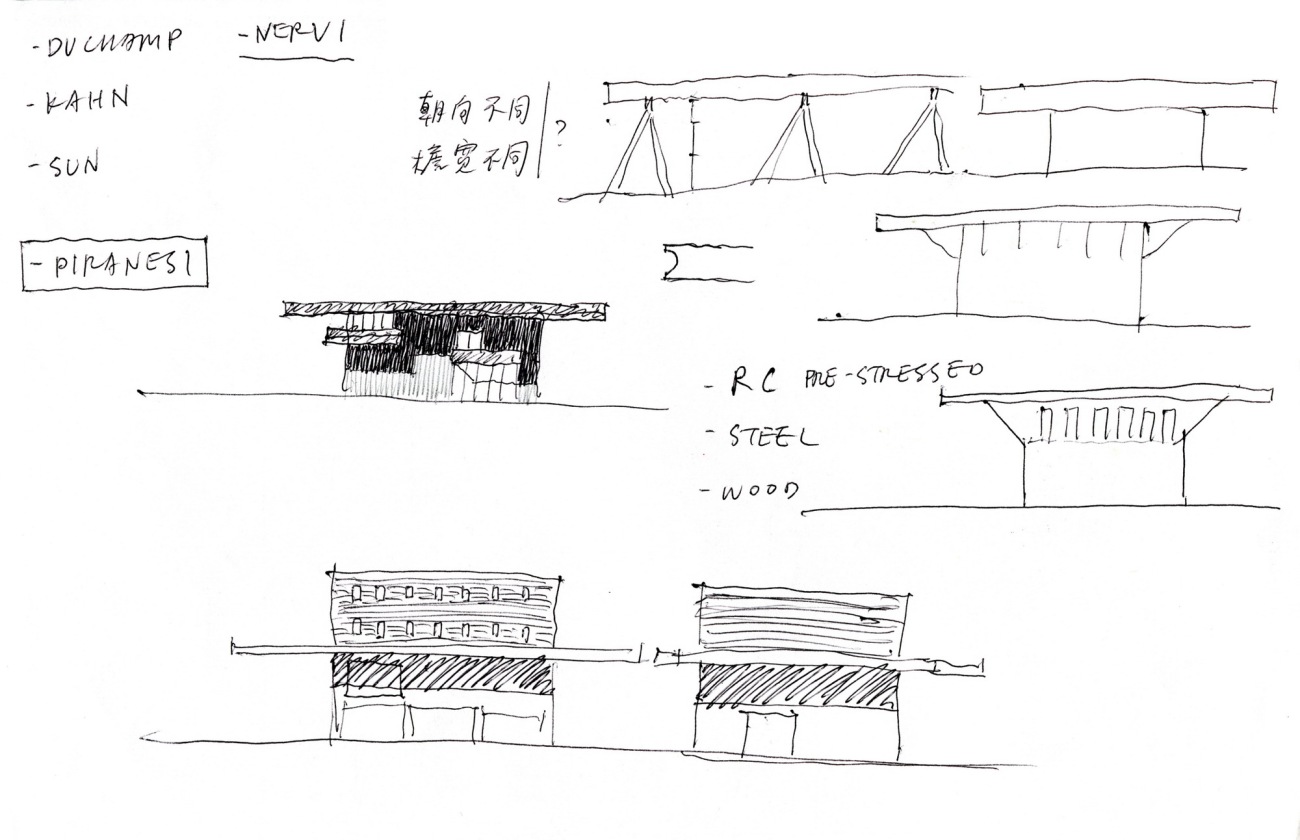
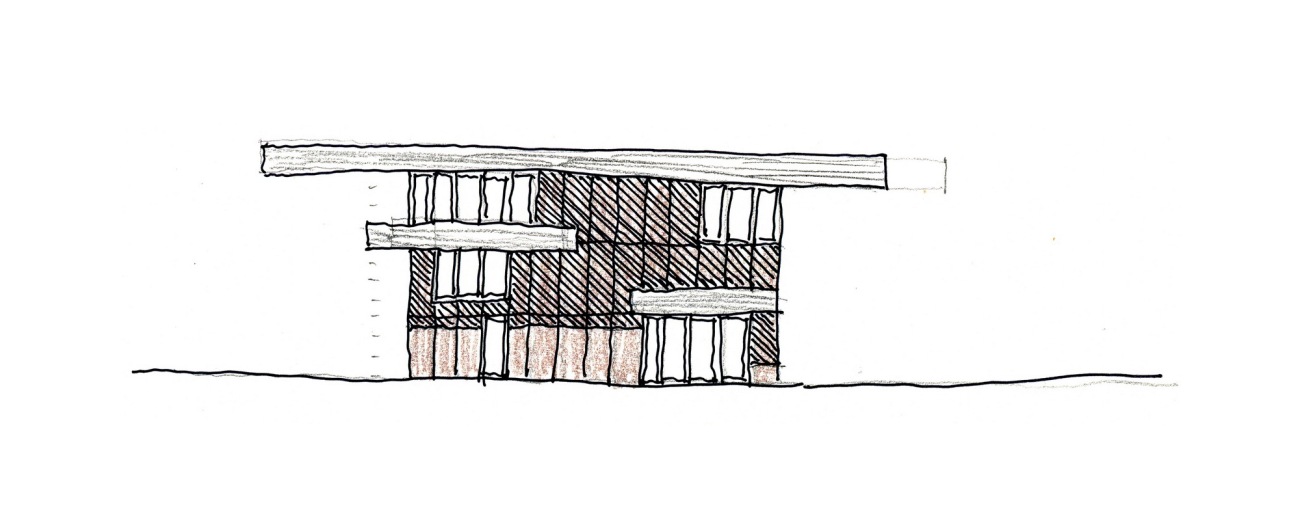
▽教学楼南侧
South side of Teaching Building
▽4号宿舍楼东侧
East side of No.4 Dormitory
50厘米宽的“一线天”使得阳光或雨水可以进入灰空间,形成既建筑又自然的景观。半室内廊下空间的形式有如一组开放的房间,在深檐的遮蔽下,可以完全不受风雨的侵扰。
The 50cm wide "sky slit" admits sunlight or rainwater into the Gray Space, crafting a landscape that blends architectural and natural elements. The veranda space takes the shape of a series of open rooms, shielded from the weather by the deep eaves.
▽每两栋建筑的挑檐之间相隔一条50厘米宽的“一线天”
The overhangs of each 2 buildings are separated by a 50cm wide “sky slit”
▽深檐下的半室外空间为行人遮阳避雨
Deep eaves create semi-outdoor spaces that keep pedestrians from the sun and rain
▽仰视一线天
Look up at the “sky slit”
▽从4号宿舍楼阳台看一线天
View of the “sky slit” from a balcony of No.4 Dormitory
▽教学楼的二层平台转角
The second floor platform of Teaching Building
▽教学楼的檐下入口
The entrance of Teaching Building under the deep eave
师生们可以在不同气候条件下,选择适当的空间进行学习、交流或其他活动。巨大的挑檐在两个建筑单体之间构成室外大厅,在这里,音乐会、体育项目等公共性的集体活动也成为了可能。通过建筑设计的独特性,我们旨在引导温州医科大学的师生们体验一种室内外界限模糊的生活方式,从中让他们更能意识到自己所处的地理环境的特点。在设计过程中,我们也从温医大的眼科专家们理解到:无论是树冠还是房檐构成的阴影下的自然光环境都是对眼睛健康最有益的。
Students and educators can opt for suitable spaces for study, communication, or other activities amid diverse weather conditions. The substantial overhanging eaves between two blocks form an open-air hall, facilitating collective public events like concerts or sports activities. Through architectural creativity, we aim to entice Wenzhou Medical University's students and faculty to embrace a lifestyle with ambiguous indoor-outdoor boundaries, fostering a heightened awareness of their geographical surroundings. During the design phase, we gained insights from the ophthalmologists at Wenzhou Medical University that underscore the ocular health benefits of the natural light environment beneath tree canopies or eaves.
▽报告厅外台阶庭院
Stepped courtyard outside Lecture Hall
▽四面围合的台阶庭院
Stepped courtyard enclosed on all sides
▽宿舍楼之间的水景
Water features between Dormitory Buildings
▽教学楼内庭院
Inner courtyard of Teaching Building
▽3号宿舍楼内庭院
Inner courtyard of No.3 Dormitory
▽4号宿舍楼的内庭院
Inner courtyard of No.4 Dormitory
▽报告厅的二层屋面平台
Second floor roof platform of Lecture Hall
▽宿舍楼阳台护栏
Dormitory balcony guardrail
03
基本结构
Structure
在这个项目中,我们采取了国内普遍使用的混凝土框架体系,并保留了混凝土表面原有的质感。
In this project, we embraced the widely adopted concrete frame system and retained the texture of the concrete surface.
▽3号楼底层餐厅
Ground floor restaurant of No.3 Dormitory
▽报告厅门厅
Lecture Hall lobby
▽活动中心室内
Interior view of Activity Center
▽阅览楼内庭院
Inner courtyard of Library
▽报告厅内景
Interior view of Lecture Hall
———————— 图 纸 ————————
▽总图
Site Plan
▽一层平面
1st Floor Plan
▽二层平面
2nd Floor Plan
▽立面+剖面
Elevations+Section
▽外墙节点
Wall Detail
项目信息 / Project Info
客户/Client:温州医科大学/ Wenzhou Medical University
地点/Location:浙江省温州市瓯海区中心东路/Zhongxin East Road, Ouhai District, Wenzhou, Zhejiang
主持设计/Principal Architect:张永和/Yung Ho Chang
项目团队/Project Team:梁小宁、于跃 、李相廷、王玥/Liang Xiaoning, Yu Yue, Li Xiangting, Wang Yue
施工图设计/Construction Drawing Design:宁波理工建筑设计研究院有限公司/Ningbo Institute of Architectural Design Co., LTD
基地面积/Site Area:38987㎡
建筑面积/Building Area:38770.2㎡
建筑高度/Building Height:24 m
建筑结构/Structure:钢筋混凝土/Reinforced concrete
设计周期/Design Period:2016-2018
竣工时间/Completion Time:2023
摄影师/Photographer:田方方/Tian Fangfang
更新日期:2023-12-27 16:02:06
非常感谢 非常建筑 带来的精彩项目, 查阅更多Appreciations towards Extraordinary building for sharing wonderful work on hhlloo. Click to see more works!
